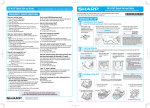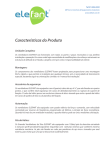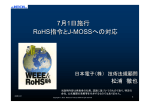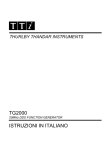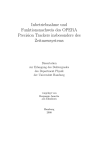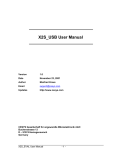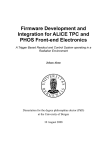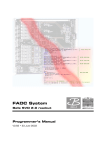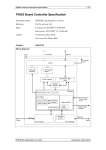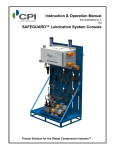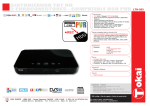Download N33-36 A Front-End DAQ with Buffer and Flexible Triggers
Transcript
A Front-End DAQ with Buffer and Flexible Triggers Y. Cui, member, IEEE, K.A. Lan, member, IEEE, E.V. Hungerford Physics, University of Houston, Houston TX 77204 Abstract - The data acquisition architecture for the tracking detector of the MECO experiment will consist of a preamplifier/discriminator feeding a buffered digitizer which will be controlled by programmed logic. The digitizer converts the timing and analog waveform into digital storage for later readout. In order to evaluate this conceptual design, a prototype system was assembled using an existing digitizer chip, which had similar characteristics to the one proposed for MECO. In this prototype system, the event readout sequence and trigger was controlled by a Xilinx FPGA, and gated data events were transferred for further processing to higher levels in the data stream. The system contained 64 input channels divided into 4 groups of 16 channels, and either anode or cathode signals could be processed. It could be operated in either an internal or external trigger mode. Test results are reported in this paper, including the maximum event rate, the system dead time, and the relationship between the system efficiency and the hitmap selection. Based on these test results, some improvements in the digitizer chip are discussed, and the specifications of our proposed digitizer are presented. Index Terms - Tracking Detector, DAQ System, FPGA, Digitizer, Front-end. I. INTRODUCTION A prototype, 64 channel DAQ system was built to prove the design concept for reading out the MECO tracking detector [1]. The challenges to the MECO DAQ system were reported elsewhere [3]. These include not only the large number of readout channels (24000), but also the experimental environment as the detector itself is placed in a sealed vacuum container and immersed in a high magnetic field). A front-end system architecture, consisting of a preamplifier-discriminator feeding a buffered digitizer which is controlled by programmed logic, was proposed. The front-end would be installed on the detector frame within the vacuum. In order to evaluate the detector performance, several sets of straw tracking detectors, and a prototype front-end system, were built to clarify problems that might arise with this design. The prototype was constructed using an existing digitizer chip from the Babar experiment [4], which has similar characteristics to our design. The system successfully worked with different straw prototypes, under different environment conditions. Test results of this prototype system are reported in this paper. II. SYSTEM ARCHITECTURE A. System Requirements and Architecture A GEANT simulation [2] of the MECO experiment shows that the tracking detector must operate at very high rate. During the muon production period (0~600ns after a beam pulse), the single event rate is about 10~15MHz per straw. Although MECO will not acquire data during this period, the system must recover for data acquisition after 600ns and remain operational until the next beam pulse ~1350ns later. The background rate during the data acquisition period is 500k/straw. The tracking accuracy, the 200µm azimuthal resolution and 2mm axial resolution, needs an electronics system having approximately 1ns TDC resolution and an 8-bit ADC for the pulse waveform. In addition, one third of the background events come from low energy protons which deposit 20 times the energy of the signal electrons. Although we are not interested in this ~5pC proton background, an electron signal of ~200fC puts severe constraints on the dynamic range of the system and system recovery after saturation. There are two methods to obtain the total charge information. One uses a large integration time to collect the charge in all clusters and measure the peak signal of the waveform. However, the long tail reduces peak resolution in a high rate environment. Another method uses a small integration time to smooth the cluster fluctuation, and integrates the signal current waveform. This tolerates a much higher rate for the same resolution, and it is used in our system. To satisfy the MECO requirements, the system consists of four blocks, 1) Preamplifier Board (PB), 2) Analog Digitizer Board (ADB), 3) Control Motherboard (CMB), and 4) Upper level DAQ system including storage. A 64-channel system is shown in Fig. 1. B. Preamplifier Board (PB) Each PB board has 16 input-channels, and is connected to the detector by a short, custom-made flexible cable in order to reduce radiation in the tracking volume. The detector signals are pre-amplified and discriminated on this board. On each PB board, four 4-channel ASD chips were used. These were designed by KEK [5] for the ATLAS thin gap chamber. This chip has a fast differential timing output and a single-ended amplitude output (16ns integration time) for each channel. 0-7803-8701-5/04/$20.00 (C) 2004 IEEE SPI Series Bus 4×(ASD-4)/FEB PA OPA DAC 2×(Elefant)/ADB Chip Select Sh Sh Shaper Shaper Gain L1_Accept Dis Dis c. Dis 8x2 PB Straw Detector Clock 60MHz Trig Pattern Trigger Decision 4 ADB Data TXER XC2S100-5PQ208C Hit point Multiplexer (XCR3128-6VQ100C) Ack FPGA SysClk 32 Vth Data Bus 8 Level Convert c. Disc. c. Readout Sequencer Address Bus Elefant Digitizer 16 Req Data Transmitter Command Receiver (XCR3128) 16k FIFO 4×(ADB)/ CMB Ext. trig. In CMB Fig 1. Structure of the Signal Readout System R3 2k R6 1k 16k +3.3V 1p Analog output R1 3.16k + OUT 5 6 Timing output C3 2.7p 11 1k C6 C2 25p 1 2 R9 510 7 0 -IN 4 3 Out +IN 14 R10 1k 6 U1A -Vs DIS OPA2690 0 11 +5V 20p +5V +Vs C1 0.1u - OUT R2 +Vs +IN 4 5 C7 0.1u 8 Out R11-5V 1k R7 100 R10 50 -IN OUT U1B OPA2690 -Vs DIS R8 100 0 0 +5V -5V +5V ASD Fig 2. Diagram of One Channel in PB Board We made a PB for the anode and for the cathode signal readout. The threshold of an anode PB is normally set at 100mV (25fC). Since the induced charge on the cathode distributes on 3~5 continuous strips, the threshold of the cathode PB is set at +300mV (75fC) allowing only the central strip to produce a timing output. Accurate timing correlation between anode and cathode helps to resolve multi-hit events. An extra gain amplifier with 100ns integration time, is connected to the ASD analog output to match the 15MHz ADC sampling rate of the current ADB board. It is not necessary for the final design to have a sampling rate higher than 40MHz. The timing output of the PB board is connected to the ADB board by a twisted-pair cable. Both short (1.5ft) and long (10ft) cables have been tested, but for the analog signal, we use a short piece of flat cable or a long multi-coax cable. Similar cables can also be used to connect the PB board to the CAMAC DAQ system. In all cases, we did not observe significant noise due to the transmission lines. C. Analog Digitizer Board (ADB) The ADB board accepts signals from the PB boards. The most important part of the ADB board is an ASIC chip, which continuously digitizes the timing and waveform, and temporarily stores the data in the on-chip buffer. Upon the arrival of a trigger, the data are readout under the control of the MB board. The Elefant chip [7] was selected as the digitizer ASIC for the prototype system. This chip was successfully used for the BaBar experiment [4] and has most of the functions we need. Fig. 3 shows the block diagram of our ADB board. CS0 8 HFA3102 LVDS OC 8 8 L1_Accept ELEFANT 8 Amp Digital Input 8 8 1 Analog Input CS1 8 HFA3102 1 OC 8 8 RD_Add ELEFANT WR_Add 8 Amp 8 8 8 Vth, Vref DAC & Driver LD SPI Fig 3. Diagram of ADB Board 0-7803-8701-5/04/$20.00 (C) 2004 IEEE 8 8 CPLD DAT Reset SysClk Trig_pattern CS2 4 SPI JTAG The ADB outputs are processed further on this board to satisfy the input requirements of the Elefant ASIC. For digital signals, LVDS signals are converted to the open collector (OC) signals by differential pairs HFA3102. Actually, this circuit can also convert ECL or NIM signal into OC signals by changing the DC operating voltage. For analog inputs, single ended signals are converted to differential signals, and at the same time, the gain is also adjusted. The electronics also allows different input polarities to be selected. The Elefant chip can produce a output “triggered” signal for each channel in every time slice when a TDC signal is present or the slope of a waveform is larger than a preassigned value. Using this signal, a Xilinx CoolRunner XPLA3 CPLD encodes a 16-bit “trigger” signal (one bit for each of 16 channels) into a 4-bit trigger pattern output. This pattern can be used by the CMB board to help make an L1 decision. When a valid trigger is presented, data is readout from the Elefant chip into the CMB board. There is also Serial Peripheral Interface (SPI) decoder logic in this CPLD. It receives the SPI commands from the CM board to control the gain of the amplifier in the Elefant chip and set the DAC values. The DAC provides the thresholds to the ASD chips and reference voltages to the Elefant chips. The former can change from -500mV to 500mV, while the later can vary from 0V to 4V. Four ADB boards can feed a CMB board through a 96-pin connector. The DACs on each ADB board can be set individually, however, the number of ADB boards controlled by one CMB is not limited to 4, and can be expanded depending on the total readout rate on the bus. Generator. All the system clocks to the devices are buffered by a clock driver, and synchronized by the DLL circuit in the FPGA. For the prototype, the upper level system is a PC with a NI 6534 DIO PCI interface card. A program written in LabView is used to control the data processing. In the final detector system, the upper level system will be a high level event builder. 1) ROC FPGA Design The ROC FPGA design is the most important part of system. It has the following functions: ∗ At power on, The ROC generates a RESET signal to initialize the whole system to a known state. After that, the ROC generates a SYNC signal periodically to synchronize the TDC counters in all the Elefant chips. ∗ During a run, when a coincident event occurs, ROC generates a delayed L1_Accept signal. This delay is needed by the latency buffer (12.6us latency time) in the Elefant chip to access the appropriate data. ∗ After generating the L1_Accept, the ROC waits for data of the current event to be moved from the latency buffer to the event buffer (about 2.2us). In this period, the ROC is dead to a new coincident event. Sync Reset Run SysClk L1_Accept D. Control Motherboard (CMB) Trigger pattern FS & CS SD SC Sync Reset Mode 6 CS 8 RD_Addr 2 WR_Addr 2 Buff_Sel 3 Data 8 L1_Accept Trig_Pattern 8 Ext Trig 2 SysClk Q 16 FDATA 16 WClk WEn RClk REn Readout Controller FPGA FIFO TXer Ack Req Data 16 Ack Req Cmd 16 OSC Clock 60MHz DLL Config OSC & Clock Generation FLASH PROM JTAG Fig 4. Diagram of CMB Board The CMB board diagram is shown in Fig. 4. A Xilinx Spartan-II FPGA is used as the readout controller (ROC) to make the trigger decision and generate the L1_Accept signal. The data from ADB are then build into a sub-event package. A 32k byte TI FIFO is used for buffering data. A Xilinx CoolRunner XPLA3 CPLD works as a transceiver (TXer) to interface the upper level DAQ system. In addition, there is a flash PROM containing the configuration data of the FPGA, a JTAG chain for in-system programming, and a Clock Start / Stop SPI Run Control Reset & Sync Generation Clk15 Generation Trigger Decision Making Logic Control clk1 Readout Sequence Control Logic Data to FIFO 8 16 stop start WR Buf RD Buf 16 2 External Trigger Wr_addr 2 8 Data from Elefant Rd_addr Vth, Sel, CS Fig 5. FPGA logic for the Readout Controller ∗ ∗ After data transfer, the ROC starts a readout process to read data from Elefant (with or without zero suppression), build an event data frame, and write it to the FIFO. If there is a new event during the readout process, the ROC temporarily saves the appropriate event flag in a buffer. When the current readout completes, the ROC starts a new process to readout this saved event. Because there are only four event buffers in the Elefant chip, there are at most 3 events waiting for readout. In order to implement these functions, this ROC FPGA has the structure in Fig. 5. It has five function blocks. ∗ Clk15 Generation. This provides 15MHz clock to other blocks in FPGA. It uses the same circuit as the one in the Elefant chip to synchronize the working frequency with the Elefant chips. In this way, all the clk15 signals in the system synchronized. 0-7803-8701-5/04/$20.00 (C) 2004 IEEE ∗ ∗ ∗ ∗ Reset & Sync Generation. This block generates ‘Reset’ and ‘Sync’, which synchronize all the logic devices in the prototype system. Run Control. This logic block controls the run start and stop when taking data. Through the SPI bus, one can configure the preset event / preset time counting mode, and set the respective register value. A counter accumulates the event recorded or the time elapsed. When the counter value reaches the register value, the current run will be stopped. Trigger Decision Logic. This block receives trigger signals from the Elefant chips in the system and external trigger signals from other detectors. Based on the configuration and the assertion of these signals, it generates an L1_Accept signal, which starts data movement from the latency buffer to the event buffer, and also enables the Readout Sequence block to readout this event after a time delay. Readout Sequence. Upon the arrival of an event trigger (L1_Accept), this block reads data from the Elefant chip, build a data frame, and write it into the FIFO. In the future, the system clock will be upgraded to 40MHz. For 60 channels with 16 time slices in an event, and 10 bits for each time slice, the estimated counting rate will be about 100kHz. If we do preprocessing in the ROC FPGA, such as baseline subtraction, ADC compensation, or peak area calculation, the output event size can be decreased by a factor of 3 or 4, and higher counting rates can be obtained. E. Trigger Decision Making An L1 decision can be programmed to implement different decision strategies, such as a self-trigger, an externaltrigger, or a coincident trigger. In the self-trigger mode, an L1 decision is made on a pattern on internal trigger signals. In an external-trigger mode, the L1 decision is made when an external trigger signal, e.g. from the calorimeter, is valid. A coincident trigger is a combination of the above two modes. III. PERFORMANCE TEST The prototype system was tested and its performance is discussed in this section. Fig. 6 shows the system with a vacuum chamber. A. Counting Rate The maximum counting rate of the system (fmax Hz) depends on the speed that buffered data can be transferred into and moved from the FIFO, as shown in Equ. 1. f max = min( f fbus , sys ) N ch * NT * B NT (1) In this equation, Nch is the channel number of an event, NT is the number of time slices to be readout, B is data width in bits of each time slice, fsys in Hz is the sampling clock, and fbus is the bus speed from the CMB to the upper level system in bits/s. In our prototype system, the sampling clock was 15MHz, and the parallel bus from the CMB to the PC was 10MHz by 16 bits (160Mb/s). We used a pulse generator to feed signal into 16 channels and read out 16 time slices for an event. Under these conditions, we reached a 60kHz counting rate, somewhat lower than the estimation of Equ.(1) due to the low processing speed of the PC and LabView programming. Fig 6. The Whole Prototype System B. Double Pulse Test An experiment was designed to check the waveform of the charge integration from the ASIC. Single or double pulses are sent to the input of an ASD chip in order to emulate the irregular time distribution of the cluster charge. The pulse width is 15ns, and the double pulse separation is 30ns. Two scope plots show the input signal (ch4) and the output amplitude from the ASD (ch2), and the shaping amplifier output (ch3). The peak values are 251mV and 151mV. The sum of 8 time slices from waveform digitizer output is 92 and 47. This signal processing method, with a 40MHz upgrade, will satisfy the required performance level for the MECO readout. C. Events lost due to TDC deadtime All the analog input signals are digitized and buffered. However, the internal logic of the Elefant digitizer requires at least three clock cycles (3×66ns) to read the next TDC data. This means that if two hits occur in one channel in less than 0-7803-8701-5/04/$20.00 (C) 2004 IEEE 200ns, a pileup waveform will occur, but the timing of the second event is lost. The clock rate in the new MECO digitizer will be 40MHz to reduce this effect. Where n is the trigger rate, τ is the deadtime (128µs), and m=4 for the Elefant chip buffers. If the trigger rate is 10kHz, this gives a 3.1% data lost. Thus a sparse readout and fewer number of time slices must be used. All the above requirements will be considered in the upgrade chip design. IV. CONCLUSION This paper describes the architecture of a data acquisition system for the MECO tracking detector. The prototype system has been designed using the Xilinx Spartan-II FPGA, CoolRunner XPLA3 CPLD and sample Elefant chips. This prototype verifies the Amplifier-Digitizer-Readout Logic system structure proposed for MECO will work as designed, although the proposed system must use a higher clock rate, and have several other features re-engineered. We anticipate that the flexibility designed into the new system will provide many opportunities to implement it in other high count rate environments. V. ACKNOWLEDGMENT This work is partly supported by the NSF and DOE. The authors acknowledge H. Von der Lippe from LBNL, who supplied the Elefant chips for our prototype and preparing upgrade chip design. Thanks also go to M. Kelsey from SLAC, BaBar Chamber group. A fruitful discussion with him helps to solve the problems in using the Elefant chip in our system design. Reference Fig. 7. The double pulse waveform of PB board D. Events lost due to the latency buffer When a trigger initiates a data read, the buffered 32 time slices of data are moved into event buffers within 2.11µs (32×66ns). Another trigger cannot initiate another read during this period, and this also produces dead-time. The percentage of the lost events equals the trigger rate times this dead-time. As discussed in a previous paper [3], the proposed upgrade to the Elefant chip will solve this problem. [1]. MECO [Online]. Available: http://meco.ps.uci.edu/ [2]. MECO collaboration, "Draft MECO Technical Proposal", Chapter 9.3, [Online]. Available: http://meco.ps.uci.edu/. [3]. K. Lan, "A Pipelined Front-end, Timing and Amplitude Digitizing System", IEEE Trans. Nucl. Sci., vol. 51, Oct. 2004. [4]. BaBar Experiment, [online] http://www.slac.stanford.edu/BFROOT/www/Detector/Ce ntralTracker/index.html. [5]. Sasaki and M. Yoshiro, "ASD IC for thin gap chamber in the LHC ATLAS experiment," IEEE Trans. Nucl. Sci., vol. 46, pp. 1871-1875, Dec. 1999. [6]. Natianal Instruments, DAQ 653X User Manual. [Online]. Available: http://ni.com/ [7]. Scott Dow, et al., "Design and Performance of the Elefant Digitizer IC for the BaBar Drift Chamber", IEEE Trans. Nucl. Sci., vol. 46, pp 785-792, Aug. 1999. E. Events lost due to the control system There are four event buffers in an Elefant chip. When they are all occupied, the system halts further triggers. The readout time for a non-sparse readout of all 64 channels, each having a 32 time slices waveform, is 128µs. The data lost due to this can be calculated by the Poisson distribution; (nτ ) m − nτ Pm (nτ ) = e m! (2) 0-7803-8701-5/04/$20.00 (C) 2004 IEEE





